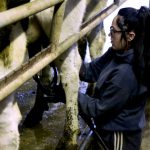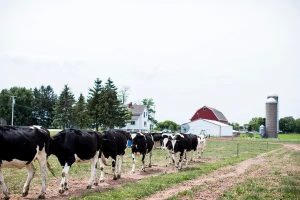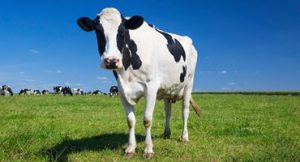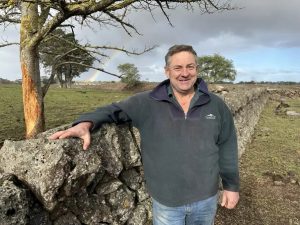
The OroBianco Italian Creamery, based in Blanco, is creating creamy dairy treats by milking a herd of actual water buffalos. Seriously.
As the herd of water buffalo slowly lurches forward, moving closer and closer, Evelio Urdaneta offers assurance: They’re not upset, they’re just curious — but cautious.
The animals, which look like large cows with textured horns, are creatures of habit, says Urdaneta, the herd manager. They like their protocols: being milked at the same time, by the same people in the same fashion each day. New things, or new people, can alarm them.
But they’re used to Urdaneta and to their routines here at Peeler Farms in Floresville.
It’s midmorning and they’ve already been milked, so their work for the day is done. They’re basking in the sun, some meandering around the edge of a pond, a few submerging themselves in the water.
The milk from that early morning ritual is ready and waiting to be picked up and trucked 80 miles north to Blanco. There, in a former dry-cleaning site turned creamery on Main Street, some of it will become cheese, maybe mozzarella or blanco fresco, a soft, spreadable type. Or it might be turned into gelato, with the frozen dessert flavored with strawberries from Poteet or peaches from Fredericksburg.
At OroBianco Italian Creamery, it’s all about the water buffalo, prized for their fatty milk that produces creamy dairy treats.
The Blanco-based business, launched in 2021, lays claim to being the first and only water buffalo creamery in Texas, and it’s rapidly expanding in the Hill Country.
A crazy idea’
It started with what Phil Giglio admits was “a crazy idea.” As a corporate lawyer from New York, Giglio’s experience in the dairy industry was limited to consumption.
“My experience was eating a lot of mozzarella in Italy,” he said, particularly in southern Italy, where his family is from. But he grew up on a farm, he said, and wanted to get out of the city. He bought a ranch in Fredericksburg in 2018.
Competing in the crowded cattle industry wasn’t appealing. Instead, he landed on something he thought would make him stand out: water buffalo milk. While the fat content of cow milk ranges from about 3% to 5%, water buffalo milk’s range is 7% to 10%, he said, so it can produce creamier products.
“We don’t have any competitors, we’re going to be the best,” he figured. He connected with Jason Peeler, who had water buffalo on his ranch alongside his cattle in Floresville. Peeler became a partner in the business, and the buffalo, which now are owned by OroBianco, live and are cared for at Peeler Farms.
OroBianco now has the creamery and storefront in Blanco, selling fresh gelato and cheeses, along with coffee and other treats — including caramel also made from, yes, water buffalo milk. In a refrigerated shipping container outside, kept at 55 degrees, wheels of aging cheeses rest in a cheese cave, under the watchful eye of head cheesemaker and partner Adam Thompson.
Inside the creamery, gelato master Ashley Contreras crafts desserts made from all-Texas ingredients, such as the citrus crema, made with fruits from the Rio Grande Valley and duck eggs from Martindale, their orange yolks lending a bright color and a custard-like texture.
OroBianco now has about 30 employees and multiple locations. In addition to the Blanco creamery, there’s a storefront in Stonewall, which also serves pizza and sandwiches made from the buffalo milk cheese. A store in downtown Fredericksburg is next, then Wimberley. The business recently opened a gelato truck in Dripping Springs and has three gelato carts: one stationed at farmers markets at the Pearl in San Antonio, one at a winery in Fredericksburg and a third on the move for weddings and events.
And it’s not all dairy: At Giglio’s property in Fredericksburg, the business also raises pigs and makes cured meats, as well as some from water buffalo meat — which, unlike their milk, is known for being lean and less fatty than cows.
Cheese challenges
Getting OroBianco to this point hasn’t been easy. Figuring out how to get the mozzarella right took more than two years — so long that it started making gelato only so it could have something to sell while it figured out the cheeses.
Unlike Giglio, Thompson had experience making cheese before joining OroBianco. He knew how to make mozzarella, but he’d always used milk from goats and cows, so he had to figure out what to do differently for the water buffalo milk.
It was a matter of getting all the variables right, like a chemistry experiment: Everything from the right amount of starter culture, which begins the process of turning milk to cheese, to the right curd size, to the temperatures and timings of each step.
Eventually, Thompson went to Lucca, Italy, to study cheesemakers, in hope of cracking the code. There, he saw how the water buffalo mozzarella should look, how it should smell and how it should taste throughout the process, before coming back to Texas and getting back to work.
After fielding inquiries about mozzarella for two years, OroBianco finally launched the product in November.
‘They’re not cows’
For Urdaneta, who works for Peeler Farms, getting used to the intricacies of water buffalo was a learning experience, too — but one he started working on more than two decades ago, in his home country of Venezuela. A trained veterinarian with an expertise in reproduction, he came to the United States in 2015 and has been working with this herd for most of the past seven years.
“They’re not cows. You can work them as a cow, but there’s a lot of behavior that’s different,” he said. There are other obvious differences. They’re bigger. While jersey cows typically weigh about 1,000 pounds, and Holsteins, the black-and-white dairy cows, weight about 1,200 to 1,500 pounds, water buffalo can weigh closer to 1,700 pounds. They eat three times as much as jerseys, Urdaneta said, and their noises are different than a cow’s moo, deeper and more guttural. Milking is also different: it takes a more constant and higher pressure than milking cows, he said.
But they also have different personalities and tendencies. They cluster together, and if one feels threatened and attacks, others in the herd will follow their lead and join in. Their personalities make some think the animals are dumb, Urdaneta said, but it’s the opposite: “They’re super smart, they just like to go at their own pace.” They need to get used to spending time with people and get used to the milking parlor before they’re willing to go along with it.
“The more time you spend with them, the more they get used to you and the more you can do,” he said. Now, they’re used to being herded up to the parlor each morning, where they’re milked mechanically with carefully-calibrated machines.
The herd of about 200 is a mix of Murrah, a breed that originates in India, and Mediterranean, which are among the most common breeds, Urdaneta said. And nearly all of them were bred and born on the ranch, he said. Since 2019, he’s been importing semen from Italy to use for artificial insemination.
The buffalo do well in Texas because they can handle just about any climate — cold, rain, heat, even extreme heat — as long as they have enough water, for wallowing.
Now, it’s pretty easy for him to understand what they like, and after working with many of them since they were calves, they know him well, too. When he whistles, they come to him, some trotting alongside the pond, and one taking the shortcut through the water to reach him. He’s named some of the bulls, including one called Gelato.
He’s as much a fan of the water buffalo products as he is of the animals themselves. The lean meat is a healthy option more people should know about, he said, while he thinks the dairy products taste better than any made with cow milk.
“When it comes to the quality of the milk, no one can match that,” he said. “If you ask me, I think all cheese needs to come out of water buffalo. You can’t beat it.”

























